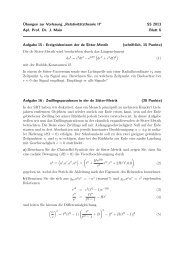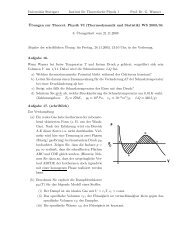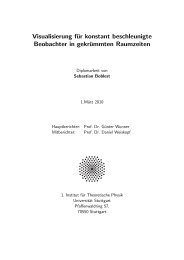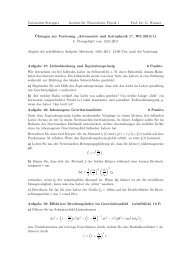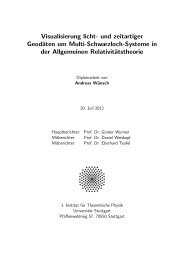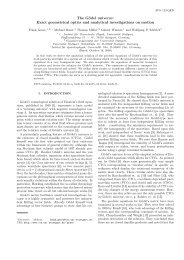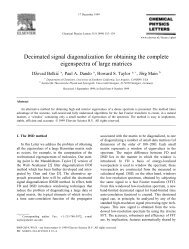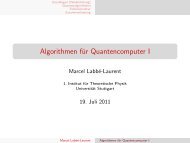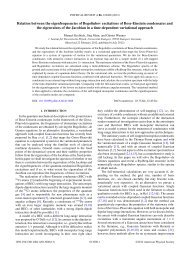2.6M - 1. Institut für Theoretische Physik - Universität Stuttgart
2.6M - 1. Institut für Theoretische Physik - Universität Stuttgart
2.6M - 1. Institut für Theoretische Physik - Universität Stuttgart
Erfolgreiche ePaper selbst erstellen
Machen Sie aus Ihren PDF Publikationen ein blätterbares Flipbook mit unserer einzigartigen Google optimierten e-Paper Software.
Summary<br />
conventions and detailed transformations of several equations. Utmost importance is<br />
attached to practical implementation. The complete printout of the source code of the<br />
used program would not be helpful. However, detailed flowcharts (Nassi-Shneiderman<br />
diagrams [22]) and listings are shown at different places to provide the reader with a<br />
deeper understanding of the simulation method.<br />
This thesis is a part of the project A15 “Numerical Methods for Many-Electron Atoms in<br />
Neutron Star Magnetic Fields” in the context of the “Sonderforschungsbereich” 382 “Procedures<br />
and Algorithms for the Simulation of Physical Processes on High-Performance<br />
Computers” - a joint project of the Universities of Tübingen and <strong>Stuttgart</strong>.<br />
Quantum Monte Carlo Method: The aim was to obtain as accurately as possible the<br />
ground state energy E0 of the many body Schrödinger equation with the Hamiltonian:<br />
ˆH = − 1<br />
N�<br />
�∇<br />
2<br />
i=1<br />
2 i +<br />
� �� �<br />
kinetic energy<br />
1<br />
N�<br />
N�<br />
1<br />
1<br />
− Z<br />
2 |�ri − �rj | |�ri|<br />
i,j<br />
i=1<br />
j �=i<br />
� �� �<br />
� �� � Coulomb potential<br />
Coulomb interaction<br />
. (1)<br />
A statistical approach is given by Quantum Monte Carlo simulations. The technique<br />
is based on walkers moving in 3N -dimensional space. N stands for the number of<br />
electrons of the atom considered and for the neutral atoms treated here is equal to the<br />
atomic number Z . The chapter starts with basics of the Quantum Monte Carlo method<br />
including<br />
� the Variational Principle [23], providing an upper bound (see equation (2.5))<br />
for the energy expectation value ET of a trial function ΨT,<br />
� the Monte Carlo Integration [18], perfectly suitable for the high dimensional<br />
integrals used here,<br />
� the Importance Sampling, increasing efficiency of the Monte Carlo integration<br />
and<br />
� the Metropolis Algorithm [17], making a statement about the acceptance probability<br />
(see equation (2.22)).<br />
The above points lead directly to the Variational Quantum Monte Carlo method<br />
(VQMC, see figure 2.1). This is one of the two simulation techniques used in this thesis.<br />
It yields an upper bound of the ground state energy<br />
126<br />
ET = lim<br />
N →∞<br />
1<br />
N<br />
N�<br />
EL( � R) (2)<br />
i=1




